Ponytail
A ponytail is a hairstyle in which some, most or all of the hair on the head is pulled away from the face, gathered and secured at the back of the head with a hair tie, clip, or other similar device and allowed to hang freely from that point. It gets its name from its resemblance to the tail of a pony.

Ponytails are most commonly gathered at the middle of the back of the head, or the base of the neck but may also be worn at the side of the head (sometimes considered formal), or on the very top of the head. If the hair is divided so that it hangs in two sections they are called ponytails, pigtails, or bunches if left loose - and pigtails, plaits or braids if plaited. Unbraided ponytails worn above each ear are sometimes called dog-ears.
Ponytails on women and girls
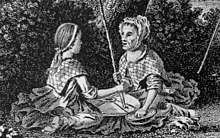
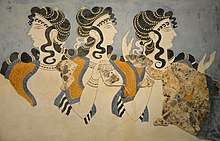
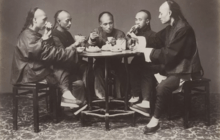
The ponytail can be traced back to Ancient Greece, from records of images depicting women with ponytails in ancient Greek artefacts and artworks, such as the frescoes painted millennia ago in Cretes (2000-1500 BC).[1] Hence, it is likely that the ponytail hairstyle emerged in Ancient Greece before spreading to other cultures and regions, for Egyptian and Roman art also depict women wearing hair in a style that we now call the ponytail.[1]
In European and Western culture, it was not usual for women (as opposed to girls) to wear their hair in public in a ponytail until the mid 20th century. This boom in the ponytail hairstyle was in large part due to the arrival of the first Barbie Doll by Mattel, which popularised the hairstyle, and film stars like Sandra Dee who wore it in films such as Gidget.[2]
Today, both women and girls commonly wear their hair in ponytails in informal and office settings or when exercising; they are likely to choose more elaborate styles (such as braids and those involving accessories) for formal occasions. The ponytail is popular with school-aged girls, partly because flowing hair is often associated with youth and because of its simplicity; a young girl is likely to be able to retie her own hair after a sports class, for example. A ponytail can also be a fashion statement; sometimes meaning sporty, other times a low pony tail sends signals of a chic personality.
A ponytail is a practical choice as it keeps hair out of the eyes when doing different jobs or hobbies. It is not uncommon to require long hair to be tied up for safety reasons in an environment like wood shops, laboratories, sporting activities, hospitals etc, even where hair nets are not mandatory. The ponytail, particularly a low ponytail, is often the most practical way to secure the hair.
As a man's hairstyle
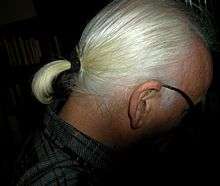
Historical
In Europe in the second half of the 18th century, most men wore their hair long and tied back with a ribbon into what we would now describe as a ponytail,[3] although it was sometimes gathered into a silk bag rather than allowed to hang freely. At that time, it was commonly known as queue; the French word for "tail". The queue lost favor amongst civilians, but continued as the mandatory hairstyle for men in all European armies until the early 19th century. The British Army was the first to dispense with it, and by the end of the Napoleonic Wars most armies had changed their regulations to make short hair compulsory.
In Asia, the queue was a specifically male hairstyle worn by the Manchu people from central Manchuria, and later imposed on the Han Chinese during the Qing dynasty. From 1645 until 1910 Chinese men wore this waist-length pigtail. The queue was utilised as a symbol of dominance over the Han Chinese by the Manchu people.[4] Being a Manchu hairstyle, it was imposed on the Han Chinese to force them into submission.[4] The queue hairstyle involves shaving the rest of the hair on the front and sides of the head, leaving a meagre portion that is tightly tied into a braid.[4] With this hairstyle, the Han Chinese could not grow their hair naturally and freely to style them as they normally did in their own culture, and were hence denied their cultural right to grow their hair comfortably, experiencing suppression and limited agency in the rule of the Qing Dynasty.[4] Any Han Chinese man who did not wear the Queue was executed by beheading.[5] This rule of law was upheld with the exception to monks, who attended monasteries and shaved their entire heads.[5] For this reason alone, many Han Chinese left their homes for monasteries to protect their freedom from this symbol of domination.[5] Otherwise, those who opposed the Queue were perceived as threats to Qing culture and power, and were purged.[5] Ironically, many of the officials who contributed to the enforcement of this law were Han Chinese who defected to the Qing.[5]
The Queue ended in 1910 after revolutions against the law through queue-cutting demonstrations, law revisions to make it more lax, and further queue-cutting demonstrations by Chinese influenced by Western democracy, all of which pressured reform in the China's law.[6] Not long after, the Qing dynasty ended in 1911 or 1912.[4]
Apart from origins in China, men in the Edo period (1683-1868) of Japan also wore short ponytails.[1] Sumo wrestlers of Japan also wore their hair in a ponytail that is then styled in a fan shape.[1] This hairstyle involving the ponytail continues in the culture of sumo wrestlers today.
Recent history
In the 1970s, many men wore their hair long and in ponytails. This look was popularized by 1970s-era rock musicians.
In the late 1980s, a short ponytail was seen as an impudent, edgy look for men who wanted to individualize, but keep their hair flat and functional (see mullet). Steven Seagal's ponytail in Marked for Death is an example. (Also see Man bun).
Scientific studies
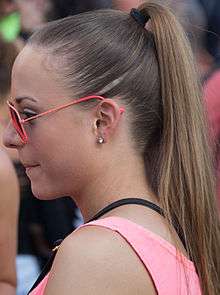
The first equation of state for hair was developed by C. F. van Wyk in 1946.[7]
Scientists in the UK have formulated a mathematical model that predicts the shape of a ponytail given the length and random curvature (or curliness) of a sample of individual hairs. The Ponytail Shape Equation provides an understanding of how a ponytail is swelled by the outward pressure which arises from interactions between the component hairs.[8]
The researchers developed a general continuum theory for a bundle of hairs, treating each hair as an elastic filament with random intrinsic curvature. From this they created a differential equation for the shape of the bundle relating the elasticity, gravity, and orientational disorder and extracted a simple equation of state to relate the swelling pressure to the measured random curvatures of individual hairs.[9][10] The equation itself is a fourth order non linear differential equation.[9]
The Rapunzel number is a ratio used in this equation to calculate the effects of gravity on hair relative to its length.[9] This number determines whether a ponytail looks like a fan or whether it arcs over and becomes nearly vertical at the bottom. A short ponytail of springy hair with a low Rapunzel number, fans outward. A long ponytail with a high Rapunzel number, hangs down, as the pull of gravity overwhelms the springiness.
It is now also known why jogger's ponytails swing side to side.[11] An up and down motion is too unstable: a ponytail cannot sway forward and backward because the jogger's head is in the way. Any slight jostling causes the up and down movement to become a side to side sway.
The research on the shape of the ponytail won the authors the Ig Nobel for Physics in 2012.[12]
The Rapunzel number is important for the computer graphics and animation industry, as it helps animators resolve challenges relating to the realistic digital representation of hair and hair movement.[8]
Health issues
It is common for those who wear tight ponytails to experience traction alopecia, a form of hair loss. Sometimes it can cause a headache.[13]:761[14] It has been proven that traction alopecia is highly associated with hair-pulling hairstyles, including the ponytail, and that hairstyles involving less tension are less associated with this condition.[15]
Additionally, people who wear ponytails may experience extracranial headaches due to tension from prolonged tying of the hairs together in a bundle, pulling at the skin of the head.[16] The pain that results is also because the ponytail pulls at the nerves in the scalp around the face, resulting in light to serious headaches or migraines.[17] Many well-known popstars who don the ponytail such as Camilla Cabello and Ariana Grande experience such pains with the ponytail after long hours of performances and rehearsals with the hairstyle.[17]
Loosening the ponytail may relieve pain and the headache, thought the extent of this varies for different individuals.[16]
See also
References
| Wikimedia Commons has media related to Ponytails. |
- Sherrow, V., (2019). "Encyclopedia Of Hair: a Cultural History." Santa Barbara: Greenwood Publishing Group.
- Whitaker, H. (2018, December 7). "A cultural history of the ponytail."
- Sherrow, Victoria (2006). "Encyclopedia of Hair: A Cultural History". Greenwood Publishing Group. pp. 310.
- Szczepanski, K. (2019, May 9). "Why Did Chinese Men Wear a Single Long Braid?"
- Chin, S., & Fogel, J. A. (2015). "The Taiping rebellion." London: Routledge.
- Godley, M. R. (1994). "The end of the Queue: Hair as symbol in Chinese History." East Asian History, 8, 53–72.
- Wyk, C. M. V. (1946). "20—Note On The Compressibility Of Wool." Journal of the Textile Institute Transactions, 37(12).
- "Science behind ponytail revealed."(2012, February 13)
- Goldstein, R. E., Warren, P. B., & Ball, R. C. (2012). "Shape of a Ponytail and the Statistical Physics of Hair Fiber Bundles." Physical Review Letters, 108(7).
- "Synopsis: Ponytail physics". Physical Review Letters. American Physical Society. Retrieved 14 February 2012.
- Keller, J. B. (2010). "Ponytail Motion." SIAM Journal on Applied Mathematics, 70(7), 2667–2672.
- "The 2012 Ig Nobel Prize Winners". Improbable Research. Retrieved August 14, 2016.
- James, William; Berger, Timothy; Elston, Dirk (2005). "Andrews' Diseases of the Skin: Clinical Dermatology." (10th ed.). Saunders.
- Freedberg, et al. (2003). "Fitzpatrick's Dermatology in General Medicine." (6th ed.). McGraw-Hill.
- Johns Hopkins Medicine. (27 April 2016). "All hairstyles are not created equal: Scalp-pulling and hair loss: What dermatologists need to know about African-American hairstyling practices and the risk of traction alopecia." ScienceDaily.
- Blau, J. N. (2004). "Ponytail Headache: A Pure Extracranial Headache." Headache: The Journal of Head and Face Pain, 44(5), 411–413.
- Bakar, F. (2018, November 5). "Is wearing a tight ponytail all the time dangerous?"
External links
- {{commons category-
ESME TOLLEY
- Whitaker, H. (2018, December 7). A cultural history of the ponytail. Retrieved from https://www.bbc.co.uk/bbcthree/article/361f113b-7edd-4589-8d2f-f1292537e1ba